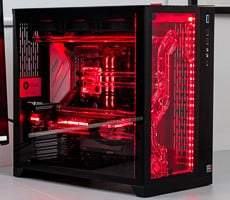DFI 855GME-MGF and Pentium-M Dothan Desktop Performance
In this our first article of 2005, we're going to take a look back at recent history and examine a driving force in computing technology that was dominant throughout much of 2004. Intel launched its mobile Centrino technology in mid-2003. It took a while to ramp up but once this new platform initiative gathered steam, it took off like a rocket for what has been a hugely successful marketing and technology development effort. The centerpiece of this new architecture was Intel's new Pentium M processor core, then code named "Banias", which has since been enhanced and updated in .09 micron process technology, now known as the "Dothan" Pentium M core.
It's no secret to many, that clock for clock Intel's new Pentium M processors are actually faster than Pentium 4 chips, in many applications. There are many reasons for this which can be attributed to architectural differences between Intel's P4 desktop chip design and the Pentium M design, including a significantly shorter pipeline along with a larger 2MB of fast, full speed L2 cache. Of course the Pentium M doesn't scale nearly as high in clock speed as a Pentium 4 but regardless, the overwhelming success and market dominance that Intel has enjoyed this past year in the mobile arena was forged by a processor architecture that will go down as one of Intel's most successful design efforts in many years.
Until now, desktop PC "enthusiasts" haven't had the ability to harness the quiet, power efficient, high performance capabilities of the Pentium M due to the obvious fact that its targeted exclusively for laptop motherboard designs. However, recently OEMs like AOpen and DFI have come out with desktop micro ATX motherboard designs that give build-it-yourself types, VARs and System Integrators the ability to build full systems based on the Pentium M and Intel's i855 Northbridge and i6300 Southbridge mobile chipset. In the pages ahead we'll be running a the new DFI 855GME-MGF motherboard, along with a 2GHz Pentium M (highly overclocked as well at 2.5GHz) through their paces versus some of the fastest Pentium 4 and Athlon 64 processors and motherboards on the market. Read on to see what the Pentium M and this new motherboard from DFI have to offer; cool, quiet high performance computing is not just for laptops anymore.
|
As you'll note the DFI 855GME-MGF's spec list above is fairly standard in terms of feature set and functionality. The main architectural differences are that this board supports up to 2GB of standard single channel DDR memory at up to 333MHz officially, although we've proven out stability at PC3200 (DDR400) speeds. In addition, it only has an AGP4X 1.5V slot and the stock front side bus speed currently is 100MHz. We took it up to 133MHz without any major issues, but more on that later. Again, this board is a micro-ATX design so it is somewhat limited in terms of expansion and I/O options. However, it does carry a host of the latest features for a board of its size. Next, we'll dig a bit deeper into the design of the board and its componentry.







